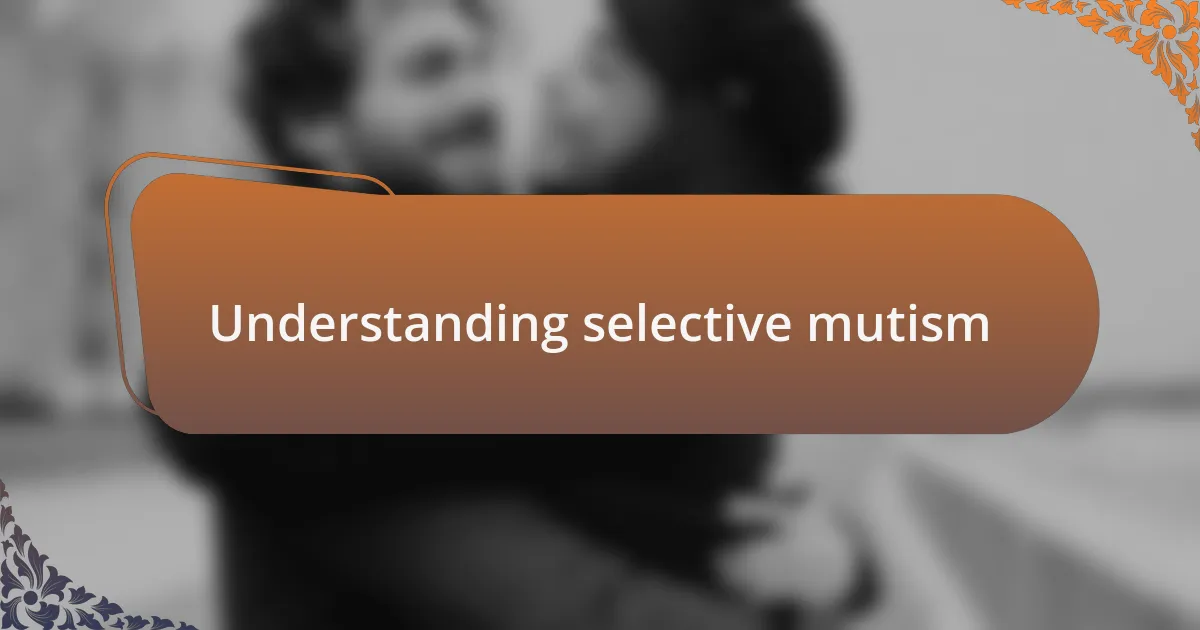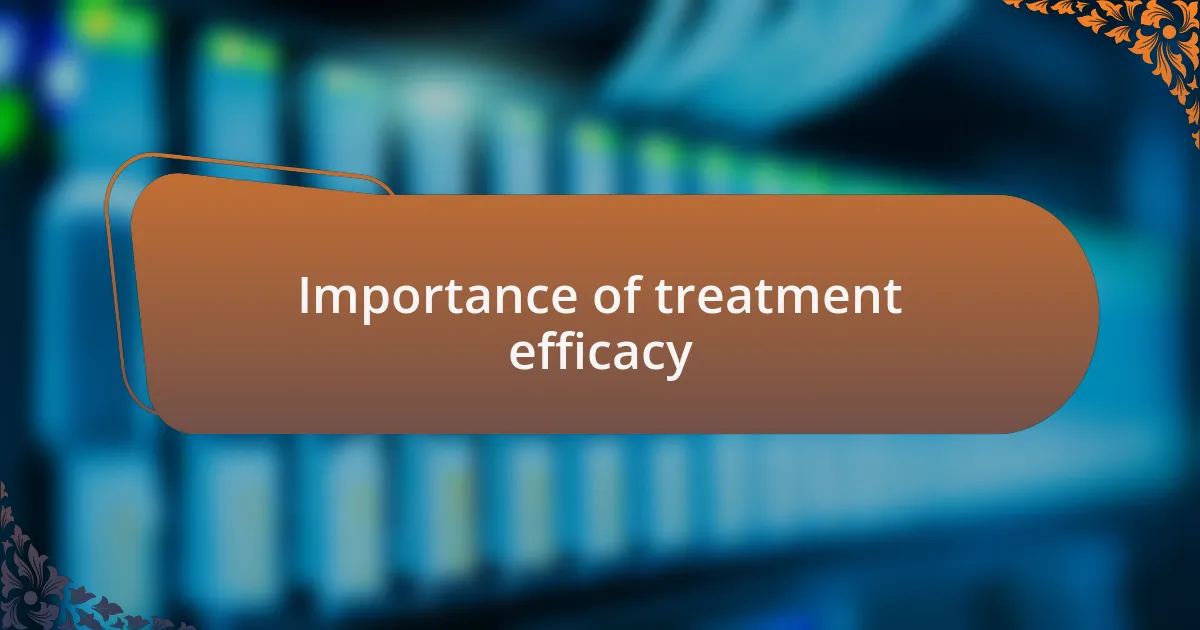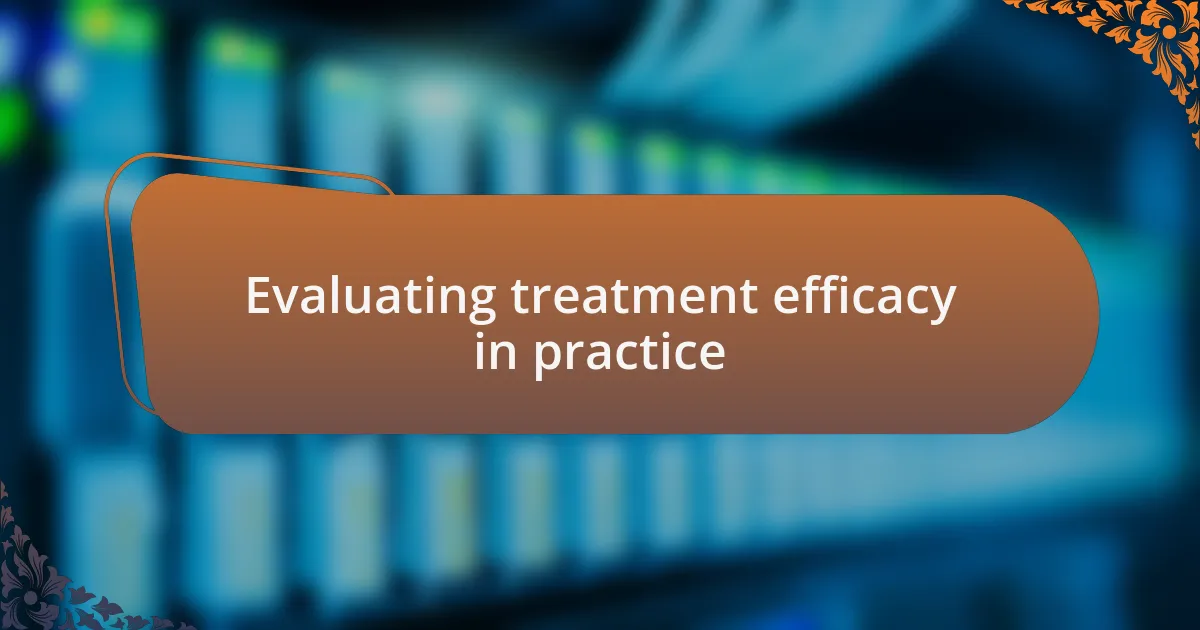Key takeaways:
- Selective mutism is often rooted in anxiety and fear in social settings, suggesting the need for supportive environments to encourage communication.
- Effective treatment options include cognitive-behavioral therapy, play therapy, and speech-language therapy, tailored to each child’s needs.
- Evaluating treatment efficacy should consider emotional growth and subtle behavioral changes, not just traditional metrics.
- Collaboration between home and school, along with playful therapy methods, can significantly enhance a child’s progress and confidence.

Understanding selective mutism
Selective mutism is more than just a hesitation to speak; it often cloaks a child’s overwhelming anxiety and fear in social situations. I remember a time when a close friend’s daughter struggled to express herself in class despite her vibrant personality at home. It made me wonder, how many bright, articulate children become shadows of themselves in front of others?
Understanding selective mutism involves recognizing the profound impact of environmental factors and individual temperament. Each experience a child has with communication can contribute to their reluctance to speak. It often raises the question: could a simple change in setting or support from a trusted adult make a world of difference for them?
Moreover, it’s important to acknowledge the emotional weight carried by those affected by selective mutism. I’ve seen parents become frustrated, feeling helpless as they watch their children fade into the background. This shared journey can lead to a stronger bond, reminding us that patience and empathy are key in supporting these children. How can we create an environment that encourages their voices to shine through?

Importance of treatment efficacy
Treatment efficacy is crucial in determining the right approach for children with selective mutism. I recall attending a workshop where a therapist shared success stories of children who thrived with the right interventions. It became clear to me that when we can effectively measure the outcomes of these treatments, we empower families to make informed decisions about their child’s path to communication.
Evaluating how well a treatment works goes beyond just numbers; it’s about witnessing real changes in a child’s life. I remember a particular moment when a child who had been virtually silent in the classroom began to interact with his peers after therapy. That transformation highlighted the significance of finding the right strategies and support systems that lead to sustainable improvements in their communication skills.
When the efficacy of treatment is emphasized, it not only builds hope for families but also fosters a sense of community among those navigating similar challenges. I often think about the power of sharing honest experiences—what worked, what didn’t, and why. Isn’t it essential that we lift each other up by celebrating these successes, helping to demystify the journey and inspire others facing the same struggle?

Common treatment options available
Treatment options for selective mutism often include cognitive-behavioral therapy (CBT), which has been a game changer for many families. I remember sitting in a session where the therapist patiently guided a young girl to express herself through gradual exposure to speaking in her comfort zone. The incremental successes she experienced showed how powerful targeted therapy can be in reshaping a child’s relationship with communication.
Another common approach is the use of play therapy. This method emphasizes the natural language of children, using play as a medium to encourage expression. I can still picture a vibrant playroom filled with toys, where children found their voices amid laughter and creativity. It struck me how such an engaging environment allowed them to communicate without the pressure that often accompanies direct conversation.
Finally, some families consider the incorporation of speech-language therapy. I’ve witnessed firsthand how working with a speech therapist can help children articulate their thoughts in safe, controlled settings. It makes me wonder—how many opportunities might we miss if we overlook the importance of these diverse treatment options? Each choice can be a stepping stone toward a child’s progress, emphasizing that there is no one-size-fits-all solution in unlocking their voice.

Evaluating treatment efficacy in practice
Evaluating treatment efficacy in practice requires an ongoing evaluation of each child’s unique needs. From my experience, it often becomes apparent that the initial enthusiasm for a chosen method may not be enough. I recall a family who started with CBT, thrilled by the initial progress, only to realize that consistency and adaptability were essential for long-term effectiveness. How do we really measure success in such nuanced cases?
I often wonder about the metrics we use to gauge a treatment’s efficacy. One family I worked with embraced journaling as a creative tool alongside therapy, documenting their child’s feelings and milestones. This practice helped them identify subtle shifts in behavior that standard assessments might miss. It makes me think—should we consider emotional growth and self-expression as vital indicators of success, even if verbal communication remains challenging?
Ultimately, evaluating treatment efficacy goes beyond standardized tests or checklists. I remember sitting down with a parent who shared how her daughter, usually quiet and withdrawn, began to engage through storytelling during sessions. The joy in her voice was undeniable. It’s moments like these that remind me of the importance of a holistic perspective when assessing whether a treatment is truly making a difference. What if we changed our focus from strictly observable behaviors to the broader context of a child’s emotional journey?

Personal experiences with treatment
Personal experiences with treatment can vary widely, and I’ve seen firsthand how important it is to tailor approaches to individual children. One client I worked with responded well to play therapy, where I was amazed to see her truly open up while interacting with dolls. It made me think—could the right environment really unlock a child’s voice?
During another session, a family introduced me to a rewards system they created at home. They used stars for every effort to communicate, no matter how small. This simple change transformed their son’s willingness to try, but it also sparked a question in my mind: what if we all celebrated small victories more often?
One of my most touching experiences involved a young girl who struggled with speaking in group settings. We began integrating music into our sessions, and I noticed a shift in her demeanor. When she sang along with us, her deep-seated fears seemed to vanish, replaced by joy. It reminded me that finding the right medium can sometimes lead to breakthroughs we never anticipated.

Insights gained from treatment outcomes
While analyzing treatment outcomes for selective mutism, one striking insight emerged: consistency in approach matters immensely. There was a child in my practice who thrived under a structured routine combined with gradual desensitization. Witnessing his progress made me wonder—could regularity be the secret ingredient that fosters confidence in other children facing similar challenges?
Another notable experience involved a group therapy session where peer support played a crucial role. A shy boy, hesitant to speak, began to mimic the vocalizations of his peers. It was powerful to see how the validation from friends encouraged him to express himself. This begs the question: can a supportive community be just as important as individual therapy in promoting progress?
Through my observations, I realized that celebrating therapy milestones, both big and small, profoundly impacts motivation. Working with a child who had long struggled to articulate thoughts, we instituted “communication journals” where he could draw or write words after each session. The pride in his eyes when he shared them with us was tangible. I found myself reflecting: how can we build more opportunities for our children to express their journey?

Recommendations for effective interventions
To effectively support children with selective mutism, I recommend incorporating a blend of individualized strategies. In my practice, I once worked with a girl who thrived after I introduced visual supports, such as picture schedules, to help her navigate social situations. Can visual cues not only ease anxiety but also empower children to engage more confidently?
Another key intervention is fostering strong partnerships between home and school environments. I recall a case where parents and teachers collaborated to implement consistent communication techniques across settings, creating a safe space for a child to practice speaking. This synergy not only helped the child feel supported but also reinforced their confidence. Doesn’t it make sense that when everyone is on the same page, progress feels more attainable?
I also advocate for incorporating games and playful interactions into therapy sessions. I found that using storytelling games transformed the experience for a child who usually struggled to voice her thoughts. The laughter we shared while creating silly narratives built not only her self-assurance but also strengthened our therapeutic relationship. How often do we overlook the fact that fun can be a powerful tool in overcoming barriers?